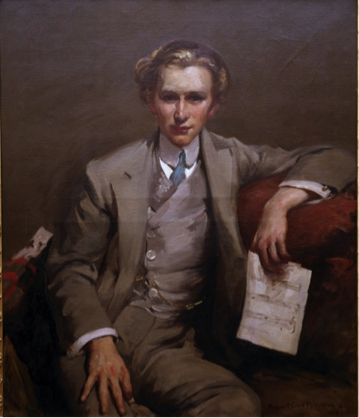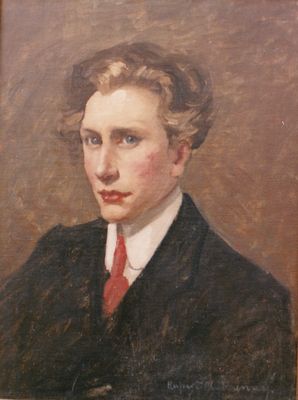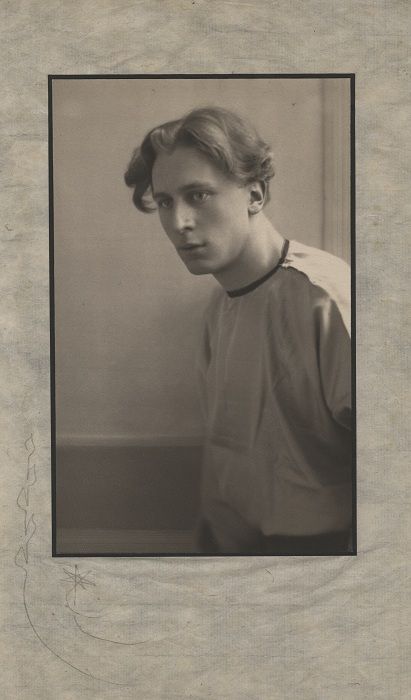Percy Grainger by Rupert Bunny
Download

Percy Grainger (1904)
oil on canvas
99.2 × 83.6 cm (sight)
Grainger Museum
University of Melbourne
0000.5005

Grainger Museum, University of Melbourne
Percy Grainger is recognised for being both a complex individual, and a composer and virtuoso pianist. The many portraits of him form an important part of the Grainger Museum’s collection.
Like Grainger, the celebrated Australian painter Rupert Bunny was a gifted musician, who played piano throughout much of his life. As a young man in London, Bunny attended part-singing gatherings at Grainger’s rooms at King’s Road and sang in a concert of Grainger’s compositions.
This portrait was commissioned by Grainger while he lived in London from 1901 to 1914, and depicts him as a relaxed young gentleman composer in the tradition of the ‘swagger’ portrait, thus reflecting Grainger’s own aspirations. Bunny has captured a tension in his sitter by articulating the taut fingers of his right hand, while from his left hand dangles a sheet of music, a deliberate reference to Grainger’s illustrious career. The portrait, like others in the Grainger Museum, immortalises Grainger’s youthful ‘Nordic’ features. It shows the interest in Grainger as a subject and his representation both as a musician and as a figure of notoriety.
Teaching ideas
The University of Melbourne’s curriculum is rich and varied, and changes from year to year. For more teaching ideas, contact a collection manager.
Personality and Social Psychology
Examine human individuality and relationships between Percy Grainger and his circle, in the context of the core themes of personality and social psychology. Study how we are unique individuals but also connected to others.
Australian Art
Use the art collection at the Grainger Museum to examine the development of the concept of ‘Australian art’ and how it was constructed from the mid-19th century to the 1960s.
Composition Seminar
Present a seminar paper on issues relating to the art and method of composition, with reference to Percy Grainger’s music.
Music Learning, Teaching and Research
Use Grainger’s music compositions in considering the historical, philosophical, psychological, sociological and methodological factors that provide a context for instrumental music teaching.
History of Sexualities
Interrogate ideas about sexualities related to the representation of Percy Grainger, with particular attention to developments from 19th-century sexologists and psychoanalysis to feminism, queer theory and intersectionality.
Collection Management
Visit the Grainger Museum’s art collection in the context of considering the issues, theory and practice of collection management as applied to collections of visual cultural material, with emphasis on works of art.
Managing Creative Content
Examine the creation and presentation of performing arts, the management of museum and gallery collections, and the administration of artistic and literary estates, as they apply to the Grainger Museum collection.
Sexing the Canvas: Art and Gender
Focus on a specific work of art at the Grainger Museum, considering what insights a gendered analysis of it can provide.
Knowledge, Learning and Culture
Visit the Grainger Museum exhibitions to experience historical, social, political and cultural influences on knowledge and the analysis of information and ideas from multiple perspectives. Encounter objects to show how direct experience can lead to greater understanding and knowledge.
Intersecting objects
-

Rupert Bunny (Australian, 1864–1947) Percy Grainger, c.
1902
oil on canvas
75.8 × 59.8 cm (frame)
Grainger Museum University of Melbourne
0000.0166 -

Adolf de Meyer (French, 1868–1949) Percy Grainger (c. 1903)
platinum print mounted on paper 25.5 × 14.0 cm
Grainger Museum University of Melbourne 01.3412
To learn more, visit the Grainger Museum website.
References
Michelle Bonollo, [Percy Grainger, by Rupert Bunny], in Chris McAuliffe & Peter Yule (eds), Treasures: Highlights of the cultural collections of the University of Melbourne, Melbourne University Publishing, 2003, p. 232.
Stella Gray, ‘Objects of desire: Portraits of Percy Grainger from his London period’, Grainger Studies: An Interdisciplinary Journal, no. 2, 2012, p. 57.
Desmond MacAulay, ‘Fantasies of the idealised self’, in Brian Allison & Jennifer Hill (eds), Hoardings: Exceptional, exotic and commonplace, Grainger Museum, University of Melbourne, 2013, p. 24.